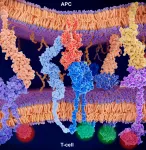(Press-News.org) Engineers at the University of Maryland (UMD) have created a new shape-changing or "morphing" 3D printing nozzle that was featured as a Frontispiece in the January 5th issue of the journal Advanced Materials Technologies.
The team's morphing nozzle offers researchers new means for 3D printing "fiber-filled composites" - materials made up of short fibers that boost special properties over traditional 3D-printed parts, such as enhancing part strength or electrical conductivity. The challenge is that these properties are based on the directions or "orientations" of the short fibers, which has been difficult to control during the 3D printing process, until now.
"When 3D printing with the morphing nozzle, the power lies on their side actuators, which can be inflated like a balloon to change the shape of the nozzle, and in turn, the orientations of the fibers," said Ryan Sochol, an assistant professor in mechanical engineering and director of the Bioinspired Advanced Manufacturing (BAM) Laboratory at UMD's A. James Clark School of Engineering.
To demonstrate their new approach, the researchers set their sights on emerging "4D printing" applications. "4D printing refers to the relatively new concept of 3D printing objects that can reshape or transform depending on their environment," said UMD mechanical engineering professor David Bigio, a co-author of the study. "In our work, we looked at how printed parts swelled when submerged in water, and specifically, if we could alter that swelling behavior using our morphing nozzle."
Recent advances in 4D printing rely on materials capable of both "anisotropic" expansion, swelling more in one direction than another, as well as "isotropic" expansion, swelling identically in all directions. Unfortunately, switching between these conditions has typically required researchers to print with multiple, different materials.
"What was exciting was discovering that we could cause a single printed material to transition between anisotropic and isotropic swelling just by changing the nozzle's shape during the 3D printing process," said Connor Armstrong, lead author of the study. Armstrong developed the approach as part of his MS thesis research at UMD.
"Importantly, the nozzle's ability to morph and to even up the score in terms of swelling properties is not limited to 4D printing," said study co-author and recently graduated mechanical engineering undergraduate student Noah Todd. "Our approach could be applied for 3D printing many other composite materials to customize their elastic, thermal, magnetic or electrical properties for example."
Interestingly, to build the morphing nozzle itself, the team actually turned to a different 3D printing technology called "PolyJet Printing." This multi-material inkjet-based approach offered by UMD's Terrapin Works 3D Printing Hub allowed the researchers to 3D print their nozzle with flexible materials for the inflatable side actuators and the shape-changing central channel, but then rigid materials for the outer casing and the access ports.
"The use of multi-material PolyJet 3D printing enabled us to design the nozzle with an operating power range or set of pressure magnitudes that can be reproduced in essentially any research laboratory," said study co-author and mechanical engineering PhD candidate Abdullah Alsharhan.
In one application of this new approach, the team is exploring the use of their strategy to realize biomedical applications in which bulk printed objects could reshape in the presence of particular stimuli from the body. The team is also in discussions with several DoD laboratories to use the morphing nozzle to support the production of weapons for defense and other military systems.
"By providing researchers with an accessible way to 3D print fiber-filled composite materials with on-demand control of their fiber orientations, and thus, their ultimate performance," Sochol said, "this work opens the door for new applications of 3D printing that harness these unique material properties and the distinctive capabilities they enable."
INFORMATION:
A survey of approximately 5,000 Americans suggests that 31.1 percent of the U.S. public does not intend to get the COVID-19 vaccine once it becomes available to them - and the likelihood of vaccine refusal is highest among Black Americans, women and conservatives.
Timothy Callaghan, assistant professor at the Texas A&M University School of Public Health, led the study with the aim of better understanding the intentions of the American public regarding vaccines. The results were recently published in Social Science and Medicine.
According to the study, survey respondents answered a series of questions about their behaviors and attitudes about COVID-19, including why or why not they intend to pursue vaccination. Women are 71 percent ...
In a paper published by the journal Matter, engineers from the University of Surrey together with partners from Harvard University, University of Science and Technology of China, UK National Physical Laboratory, George Washington University and Zhejiang University Ningbo Research Institute report on how they have developed a breakthrough sensor system and manufacturing process.
The global team of engineers reveal that the new contact lens sensor system contains a photodetector for receiving optical information, a temperature sensor for diagnosing potential corneal disease and a glucose sensor ...
Musical masterworks as the Queen of the Night's Aria from Mozart's The Magic Flute, are examples of the sounds trained human voices can produce. The precondition for vocal virtuosity as well as for any spoken word is vocal learning, the ability to imitate auditory input. Some songbirds and bats can do this, but humans excel. We can acquire new languages into old age. To shed light on the evolution of vocal learning, a team led by Julia Fischer from the German Primate Center (DPZ) - Leibniz Institute for Primate Research has analyzed the sound structures of Guinea baboons and was ...
CLEVELAND - In a new paper, researchers describe their development of a near-real time spatial assessment of COVID-19 cases to help guide local medical responses to clusters of outbreaks of the virus at the local level.
The paper, entitled "Geographic monitoring for early disease detection (GeoMEDD)," appeared in the Dec. 10 issue of Nature Scientific Reports and comes from researchers at Case Western Reserve University (CWRU) School of Medicine, University Hospitals (UH) Cleveland Medical Center, and Texas A & M University.
While developing a tracking system during the beginning stages of the COVID-19 pandemic, ...
A first-of-its-kind study conducted under the bed of the Dead Sea reveals that a devastating earthquake measuring 6.5 on the Richter scale is expected to hit our region in the coming years. The study showed that an earthquake of this magnitude occurs in the land of Israel on an average cycle of between 130 and 150 years, but there have been cases in history where the lull between one earthquake and another was only a few decades long.
The last earthquake with a magnitude of 6.5 on the Richter scale was felt in the Dead Sea valley in 1927, when hundreds of people were injured in Amman, Jerusalem, Bethlehem and even Jaffa. Now, in the wake of the findings ...
A microbe found in the colon and commonly associated with the development of colitis and colon cancer also may play a role in the development of some breast cancers, according to new research from investigators with the Johns Hopkins Kimmel Cancer Center and its Bloomberg~Kimmel Institute for Cancer Immunotherapy. Breast tissue cells exposed to this toxin retain a long-term memory, increasing the risk for disease.
In a series of laboratory experiments, researchers discovered that when enterotoxigenic Bacteroides fragilis (ETBF) was introduced to the guts or breast ducts of mice, it always induced growth and metastatic progression of tumor cells. A description of the work is published in the January 6 issue of the journal Cancer Discovery.
While microbes are known to be present in ...
DALLAS - Jan. 6, 2020 - UT Southwestern scientists have developed a new method to study the molecular characteristics of T cells, critical immune cells that recognize and attack invaders in the body such as viruses, bacteria, and cancer.
The approach, described today in the journal Nature Methods, enables researchers to more easily analyze the roles of T cell receptors (TCRs) - the molecules on the surfaces of T cells that are responsible for recognizing pathogens.
"This could lead to a better understanding of how T cells work as well as new ways to harness T cells to fight disease," ...
Philadelphia, January 6, 2021 - A multidisciplinary team of researchers led by Children's Hospital of Philadelphia (CHOP) has discovered several genetic markers associated with bone mineral accrual, which could ultimately help identify causes of eventual osteoporosis earlier in life through genetic testing. The findings, which were made possible by following a group of children over several years, were published online by the journal Genome Biology.
Osteoporosis is widely considered a disease of old age. However, the accrual of bone density early in life is critical for achieving optimal bone mass in adulthood ...
Using a blood test, a German-Dutch research team has predicted the risk of Alzheimer's disease in people who were clinically diagnosed as not having Alzheimer's disease but who perceived themselves as cognitively impaired (Subjective Cognitive Declined, SCD). The researchers analyzed blood samples from an SCD cohort supervised at the Alzheimer Center Amsterdam. Using a test developed at Ruhr-Universität Bochum (RUB) called the Immuno-Infrared Sensor, they identified all 22 subjects at study entry who developed Alzheimer's dementia, thus the clinical symptoms, within six years. The test ...
Maybe you're like us. We're the folks who are on our smartphones almost all the time, even when we're with others. We know it annoys a lot of people, but we do it anyway. Why?
Researchers at the Norwegian University of Science and Technology (NTNU) have looked at why people in cafés pull out their phones, and how this affects café life. Three main reasons they identified are: to delay or pause a conversation (interaction suspension); to get out of a conversation (deliberately shielding interaction); and to share something with others (accessing shareables).
But what does that actually mean?
The smartphone is the world's most ubiquitous personal tech gizmo. ...




